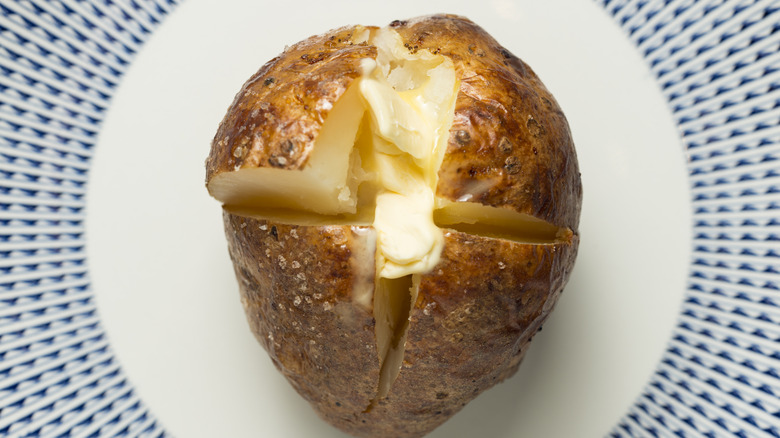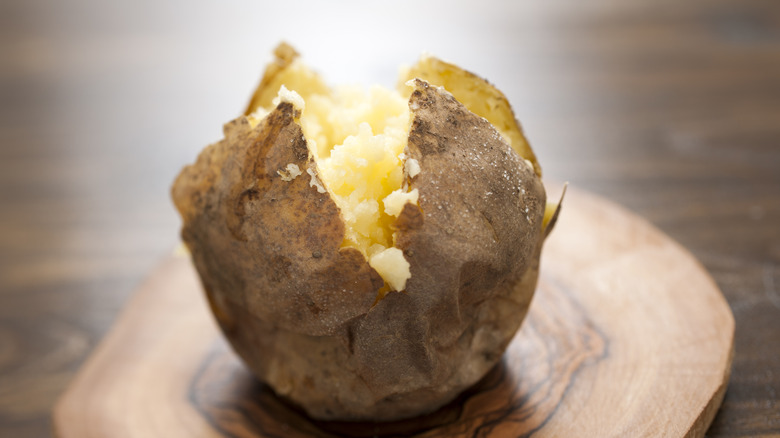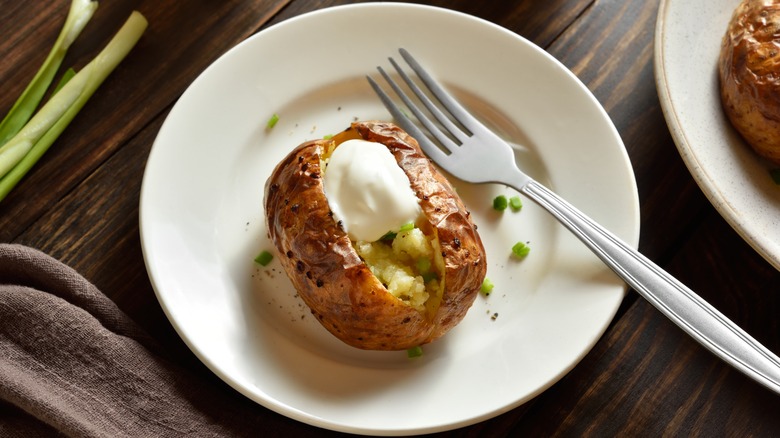What's The Best Temperature To Bake Potatoes At, Really?
As straightforward and simple as it is to make a baked potato — the base of so many comfort meals and a must-have, classic side — the task of properly baking a spud is a bit more nuanced than you might think. You have to choose the type of potato you want, as well as how to prep it, wash it, prick it, and wrap it in aluminum (don't do this step if you're after a crispy potato). There's a lot that goes into making a homemade potato taste restaurant-worthy — meaning a perfectly fluffy, creamy creation that doesn't need oodles of butter or salt to make it taste heavenly.
The right baking temperature is a key component to mastering such a potato, but don't obsess over the oven temp — in fact, it's the internal temperature that can elevate the humble baked tater into something worth writing home about. Depending on who you ask, you may get a slew of conflicting takes on the best way to bake a potato, but the internal temp is what you should pay attention to. This should fall between 205 and 212 degrees Fahrenheit. Meaning, if you're serious about perfecting the comfort food classic or find yourself making unsatisfying, under- or over-cooked potatoes too often, investing in a cheap probe thermometer pays off in spuds — er, spades.
Internal temperature is the number that matters for optimal texture
As we'll discuss more later, the jury's still out on the unequivocal best oven temp for baking potatoes. But you don't have to worry about this — what truly matters is the internal temperature: the number a thermometer reads when it's stuck into the center of a freshly baked potato. This can only be tested with a probe temperature, so pick one up at a kitchen supply store or online.
When the potato looks like it's done, check for a temperature between 205 and 212 degrees Fahrenheit. This range ensures the potato will be light, airy, and fully cooked all the way through. As potatoes cook, their starchy innards swell up with moisture from the spud, and thanks to this steam, the potato expands and puffs out, creating the fluffy texture you want. All this internal expansion is why recipes instruct you to prick small holes with a fork; these help you avoid an explosion! Achieving the right temperature ensures the carb-y insides will be moist but not too moist, and that they'll easily give way when cut into — no more biting into tough, still-hard spuds. If your thermometer doesn't display this temperature or you can't easily prick the potato, keep cooking it a bit longer. (Comparatively, slightly less starchy sweet potatoes have smaller starch granulates, so they don't fluff up to the same height, instead turning more creamy when baked. Because of this, their baking approach will be different.)
Oven temps can vary depending on the potato
Look at 10 recipes and you'll come away with 10 different takes on the best oven temperature for baked potatoes. That's because there's no one right temp, and it depends largely on the variety and size of the potato you're making. Of course, a larger potato will need more cooking time, and if you're squeezing potatoes in with other dishes at a lower oven temp, they can take upwards of an hour. You will see recipes calling for an oven preheated to 250 degrees Fahrenheit all the way up to 450 degrees Fahrenheit. Just don't crank up the heat too high for the sake of speed — your potato may just burn up. At the end of the day, always keep a close eye on the internal temp, and look out for telltale signs like blistering or super dark skins, which may indicate that they're overcooked or the oven was too hot.
Once you have your perfectly cooked tater, what toppings you pile on it are up to you. Stay classic with butter and salt and maybe a dollop of sour cream, or load 'em up with all the fixings. You can also do as the Brits do, turning the potato into a protein-packed meal by sandwiching a hot dog inside the potato for a Guy Fawkes night-inspired dish.


